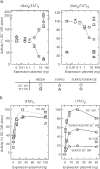A small conserved surface in SUMO is the critical structural determinant of its transcriptional inhibitory properties
- PMID: 15870296
- PMCID: PMC1087732
- DOI: 10.1128/MCB.25.10.4272-4282.2005
A small conserved surface in SUMO is the critical structural determinant of its transcriptional inhibitory properties
Abstract
Small ubiquitin-like modifier (SUMO) modification of sequence-specific transcription factors has profound regulatory consequences. By providing an intrinsic inhibitory function, SUMO isoforms can suppress transcriptional activation, particularly at promoters harboring multiple response elements. Through a comprehensive structure-function analysis, we have identified a single critical sector along the second beta sheet and the following alpha helix of SUMO2. This distinct surface is defined by four basic residues (K33, K35, K42, R50) that surround a shallow pocket lined by aliphatic (V30, I34) and polar (T38) residues. Substitutions within this area specifically and dramatically affected the ability of both SUMO2 and SUMO1 to inhibit transcription and revealed that the positively charged nature of the key basic residues is the main feature responsible for their functional role. This highly conserved surface accounts for the inhibitory properties of SUMO on multiple transcription factors and promoter contexts and likely defines the interaction surface for the corepressors that mediate the inhibitory properties of SUMO.
Figures









Similar articles
-
Swapping small ubiquitin-like modifier (SUMO) isoform specificity of SUMO proteases SENP6 and SENP7.J Biol Chem. 2011 Oct 14;286(41):36142-36151. doi: 10.1074/jbc.M111.268847. Epub 2011 Aug 30. J Biol Chem. 2011. PMID: 21878624 Free PMC article.
-
Identification of a non-covalent ternary complex formed by PIAS1, SUMO1, and UBC9 proteins involved in transcriptional regulation.J Biol Chem. 2013 Dec 20;288(51):36312-27. doi: 10.1074/jbc.M113.486845. Epub 2013 Oct 30. J Biol Chem. 2013. PMID: 24174529 Free PMC article.
-
Solution structure of human SUMO-3 C47S and its binding surface for Ubc9.Biochemistry. 2005 Mar 1;44(8):2790-9. doi: 10.1021/bi0477586. Biochemistry. 2005. PMID: 15723523
-
SUMO association with repressor complexes, emerging routes for transcriptional control.Biochim Biophys Acta. 2009 Jun-Aug;1789(6-8):451-9. doi: 10.1016/j.bbagrm.2009.07.001. Epub 2009 Jul 17. Biochim Biophys Acta. 2009. PMID: 19616654 Review.
-
Protein modification by SUMO.Annu Rev Biochem. 2004;73:355-82. doi: 10.1146/annurev.biochem.73.011303.074118. Annu Rev Biochem. 2004. PMID: 15189146 Review.
Cited by
-
Histone sumoylation is a negative regulator in Saccharomyces cerevisiae and shows dynamic interplay with positive-acting histone modifications.Genes Dev. 2006 Apr 15;20(8):966-76. doi: 10.1101/gad.1404206. Epub 2006 Apr 5. Genes Dev. 2006. PMID: 16598039 Free PMC article.
-
Sumoylation is Largely Dispensable for Normal Growth but Facilitates Heat Tolerance in Yeast.Mol Cell Biol. 2023 Jan;43(1):64-84. doi: 10.1080/10985549.2023.2166320. Mol Cell Biol. 2023. PMID: 36720466 Free PMC article.
-
SUMO Interacting Motifs: Structure and Function.Cells. 2021 Oct 21;10(11):2825. doi: 10.3390/cells10112825. Cells. 2021. PMID: 34831049 Free PMC article. Review.
-
Chromatin modification by SUMO-1 stimulates the promoters of translation machinery genes.Nucleic Acids Res. 2012 Nov 1;40(20):10172-86. doi: 10.1093/nar/gks819. Epub 2012 Aug 31. Nucleic Acids Res. 2012. PMID: 22941651 Free PMC article.
-
Inhibition of CDK1 activity by sumoylation.Biochem Biophys Res Commun. 2016 Sep 16;478(2):919-23. doi: 10.1016/j.bbrc.2016.08.051. Epub 2016 Aug 10. Biochem Biophys Res Commun. 2016. PMID: 27520372 Free PMC article.
References
-
- Abdel-Hafiz, H., G. S. Takimoto, L. Tung, and K. B. Horwitz. 2002. The inhibitory function in human progesterone receptor N termini binds SUMO-1 protein to regulate autoinhibition and transrepression. J. Biol. Chem. 277:33950-33956. - PubMed
-
- Bailey, D., and P. O'Hare. 2004. Characterization of the localization and proteolytic activity of the SUMO-specific protease, SENP1. J. Biol. Chem. 279:692-703. - PubMed
-
- Bies, J., J. Markus, and L. Wolff. 2002. Covalent attachment of the SUMO-1 protein to the negative regulatory domain of the c-Myb transcription factor modifies its stability and transactivation capacity. J. Biol. Chem. 277:8999-9009. - PubMed
-
- Bohren, K. M., V. Nadkarni, J. H. Song, K. H. Gabbay, and D. Owerbach. 2004. A M55V Polymorphism in a novel SUMO gene (SUMO-4) differentially activates heat shock transcription factors and is associated with susceptibility to type I diabetes mellitus. J. Biol. Chem. 279:27233-27238. - PubMed
Publication types
MeSH terms
Substances
Grants and funding
LinkOut - more resources
Full Text Sources
Other Literature Sources
